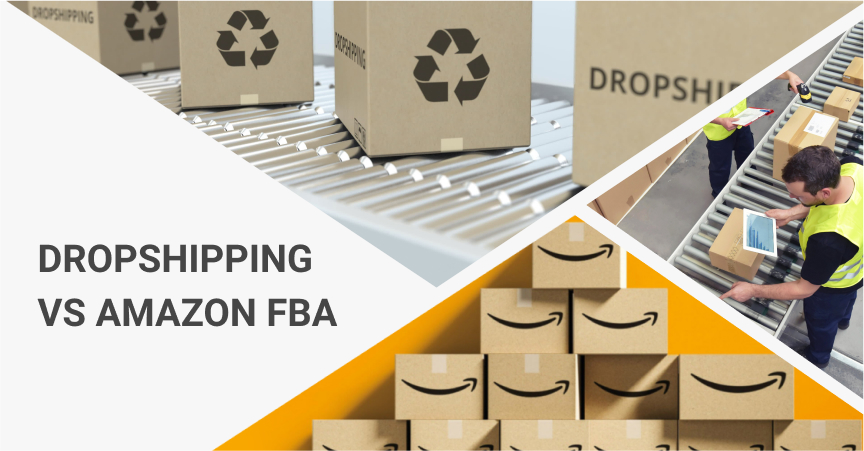Dropshipping Vs Amazon FBA: Pros & Cons For Entrepreneurs

This article compares dropshipping vs Amazon FBA program. These two business models share similar features, which often makes it difficult to choose between them. Keep reading to learn about their pros and cons.
What is the dropshipping business model?
Dropshipping business is based on selling products without buying them beforehand. The retailer only pays for goods after customers order them. After that, the original product supplier sends these goods directly to customers.
This model benefits retailers and suppliers alike. Retailers don’t have to store, pack and ship products, while suppliers can sell goods to customers with no marketing efforts.
Dropshipping has a number of other pros as well as cons which we will see when comparing dropshipping vs Amazon FBA.
What is Fulfilment by Amazon?
Amazon FBA is a service that provides storage, packing and shipping to small businesses and retailers.
Simply speaking, you pay Amazon either a monthly fee or a fixed amount of money for each product you want to sell. In exchange, Amazon stores whatever products you send them in one of its huge warehouses. After that, you can see these products on Amazon. Whenever somebody buys them, the company packs the products and sends them to the customers while you get the money.
Amazon also provides customer service.
Comparing dropshipping vs Amazon FBA
These two models look very similar. However, they also have serious differences, so let’s take a deeper look.
Independence

When it comes to Amazon, a lot of issues can arise from the fact that entrepreneurs sell products on a platform that actually belongs to another company. At the very least, they have to play by someone else’s rules.
Moreover, Amazon gathers various data that shows it what customers prefer and what products sell better than others. It was reported that the platform copies the most successful products to drive its own sellers from the market.
What’s worse, Amazon has already demonstrated what it is capable of by locking out independent sellers because of the coronavirus outbreak. The company suspended the shipment of non-essential products, which put thousands of entrepreneurs out of business.
Although Amazon’s efforts to provide customers with essential goods is understandable, it’s a poor excuse for leaving thousands of people with no work.
In comparison, when you create a dropshipping store with the help of the AliDropship plugin or similar solutions, you become a full, independent owner of this business.
Investments

Both dropshipping and the FBA program require a starting budget. In dropshipping, one needs to pay for a website, dropshipping software, promotion campaigns to drive traffic to the site, etc. Retailers who want to sell on Amazon, in turn, have to buy products in bulk and pay for participating in the program.
However, dropshipping requires less initial investments compared to Amazon FBA. For example, to start a dropshipping store with the AliDropship plugin, one needs only $134. You will also need a certain budget to test products (a minimum of $5 a day per product).
Fulfilled by Amazon requires that Amazon sellers buy or manufacture products in advance in large quantities, which can cost $1,000 and more.
Risks

Any business carries risks no matter what model you apply. The worst thing for any business is being unable to sell products and services: you’ve invested a ton of money into an inventory which brings no profit at all!
But unlike traditional business models, dropshipping offers an important advantage – retailers order goods from suppliers only after customers buy them. Therefore, dropshipping is less risky compared to FBA.
Scaling up the business

In both models, it’s really difficult to predict whether your product will sell well and in large quantities. However, since in dropshipping you don’t have to buy goods in advance, you can test not just one but various products simultaneously by investing relatively small sums of money in advertising. If a product fails, that’s all the money you lose. Once you find a good product, it’s easy to focus all your marketing efforts on it to start earning more money.
Note that if you purchase AliDropship’s Premium or Established stores, your chances to succeed are much higher since these websites already have winning products tested by our team.
In contrast, if you purchase or manufacture goods in advance for Amazon and they fail to sell well, you lose much more money since you’ve already paid for these goods. Besides, even if you succeed, you’ll need to accumulate enough money to reinvest before you can scale up your business.
Thus, after finding a best-selling product, one can scale up a dropshipping business very quickly.
Comfort

Although dropshipping requires fewer investments to start, one needs to pay a lot of attention to various aspects of this business to make it successful. You need to create and run Instagram and Facebook ads, process orders, respond to unsatisfied customers, run social media accounts, take care of email marketing, etc.
When you sell goods on Amazon, you benefit from the platform’s brand. Everyone buys on Amazon! It doesn’t mean this business doesn’t require promotion: after all, you have to compete with other Amazon sellers. But the amount of effort needed is less compared to dropshipping.
So, Amazon FBA is more comfortable to run.
Audience targeting options

Although sellers using the FBA program do benefit from access to Amazon’s enormous customer base, this is also a disadvantage. Amazon provides no customer data to sellers meaning one cannot target a specific audience.
At the same time, dropshipping businesses are totally free to target fresh audiences as well as retarget existing customers and lookalike audiences, thus, building their own customer base in the long-term. In capable hands, this can become a strong advantage.
Service quality

If you compare dropshipping vs Amazon FBA, in both cases, entrepreneurs outsource packing and shipping tasks to a third party.
There’s no doubt that Amazon provides excellent quality service: you don’t have to worry about products getting damaged. Even if it happens, the company takes full responsibility for such issues.
However, an ecommerce store based on the dropshipping model can’t be absolutely certain about it. It doesn’t mean all dropshipping suppliers provide low quality service. But one has to find good suppliers first.
In other words, FBA sellers already have a reputable partner who provides excellent service while dropshipping businesses will have to find them first.
Competition

It’s actually pretty difficult to compare the two models by competition level because it’s very high in both cases.
On the one hand, a dropshipping store has to compete with other ecommerce shops selling the same or similar goods AND with Amazon, a huge online business. On the other hand, the same goes to Amazon retailers who also have to compete with each other if they work in the same niche.
Although you will face fierce competition in both cases, dropshipping stores are less “visible” which makes them harder to copy unlike Amazon shops. From this perspective, dropshipping is a bit safer.
Dropshipping vs Amazon FBA: Conclusion
Amazon FBA might be an easier way to start selling pre-purchased products online as a generic retailer with no specific brand image. It lets you benefit from the platform’s name and enormous customer base. At the same time, in dropshipping, you have an opportunity to create and promote your own independent brand and be much more flexible while targeting specific customer segments.
Besides, dropshipping gives you much more business freedom as you are not limited or controlled by a ‘parenting’ platform. And what’s most important for newcomers, dropshipping requires less capital to start – and no product inventory at all.
As an independent entrepreneur, you are free to choose any dropshipping store option that suits you most, and run your business at your own pace.

tutorials and special offers from AliDropship













